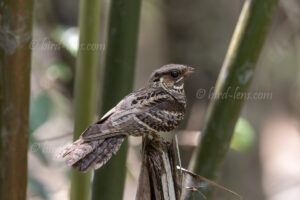 In the middle of the day in the sparse mangrove thicket of the Kuala Selangor Nature Park the heat is murderous. But this is probably no surprise for a landscape almost at the equator. Suddenly a brown bird flies up from the side of the path that runs along a dike through the mangrove forest. It flies elegantly around the thin tree trunks and lands on a horizontal branch about 2.50 meters high. The distance is not so far that the outline of a Nightjar can be clearly seen. Unfortunately the bird sits against the light; not very favourable for photo shots. I approach the with the Canon EF 400mm f/2.8L IS II USM lens on a Canon EOS R5 mounted to the Gitzo monopod GM4542. The bird allows the approach quite well, but flies up in the last meter. This time the Nightjar flies much lower between the trunks, the thick, thorny leaves of the palm trees and the stilt roots of the mangroves and sits on a broken palm leaf just 8 meters away. This is the perfect photo position. The research reveals a Large-tailed Nightjar (Caprimulgus macrurus) – probably a female that I may have spooked on her breeding site. It flies around me for a while, but no longer takes up space so beautifully and openly. The longer it takes, the more resting places deeper in the mangrove thicket are used. The bird also flies up completely unprovoked and changes position. Since I suspect that I may have frightened the bird at its breeding site, which must then be right next to the circular path, I start a search for a clutch of eggs. But the search is unsuccessful.
In the middle of the day in the sparse mangrove thicket of the Kuala Selangor Nature Park the heat is murderous. But this is probably no surprise for a landscape almost at the equator. Suddenly a brown bird flies up from the side of the path that runs along a dike through the mangrove forest. It flies elegantly around the thin tree trunks and lands on a horizontal branch about 2.50 meters high. The distance is not so far that the outline of a Nightjar can be clearly seen. Unfortunately the bird sits against the light; not very favourable for photo shots. I approach the with the Canon EF 400mm f/2.8L IS II USM lens on a Canon EOS R5 mounted to the Gitzo monopod GM4542. The bird allows the approach quite well, but flies up in the last meter. This time the Nightjar flies much lower between the trunks, the thick, thorny leaves of the palm trees and the stilt roots of the mangroves and sits on a broken palm leaf just 8 meters away. This is the perfect photo position. The research reveals a Large-tailed Nightjar (Caprimulgus macrurus) – probably a female that I may have spooked on her breeding site. It flies around me for a while, but no longer takes up space so beautifully and openly. The longer it takes, the more resting places deeper in the mangrove thicket are used. The bird also flies up completely unprovoked and changes position. Since I suspect that I may have frightened the bird at its breeding site, which must then be right next to the circular path, I start a search for a clutch of eggs. But the search is unsuccessful.
Although the literature on the breeding behavior of the species states that in parts of the bird’s distribution area the Large-tailed Nightjar breeds loosely as a colony breeder, this bird was obviously alone. The nesting site is very well characterized as “…under trees or bushes, near stones, on lawns or grass, in open areas, on the edges of forests and forests…”. The fact that no nest is built and the eggs are laid on leaf litter, bare earth or pure sand would also speak for the location. Adult Large-tailed Nightjars are known to exhibit enticement behavior when they feel threaten themselves or their brood at the nesting site. They then carry out diversionary maneuvers in which injuries are feigned. It is quite possible that what was observed was a diversionary tactic. But I didn’t notice that injuries were feigned.
In order to meet the growing demand for top images of the rarer species of Palaearctic Bird-lens.com has specifically made trips to remote places. Additionally every chance is used, if a rare bird is around the homeground. This to do everything to ensure excellent photos of the Birds of the Western Palearctic. The yield of pictures also of rare Western Palaearctic birds is very good. There are other nice images of birds, that you will find behind the tab “Picture Shop“. Just give a notice if you need a picture of a bird which is not online.